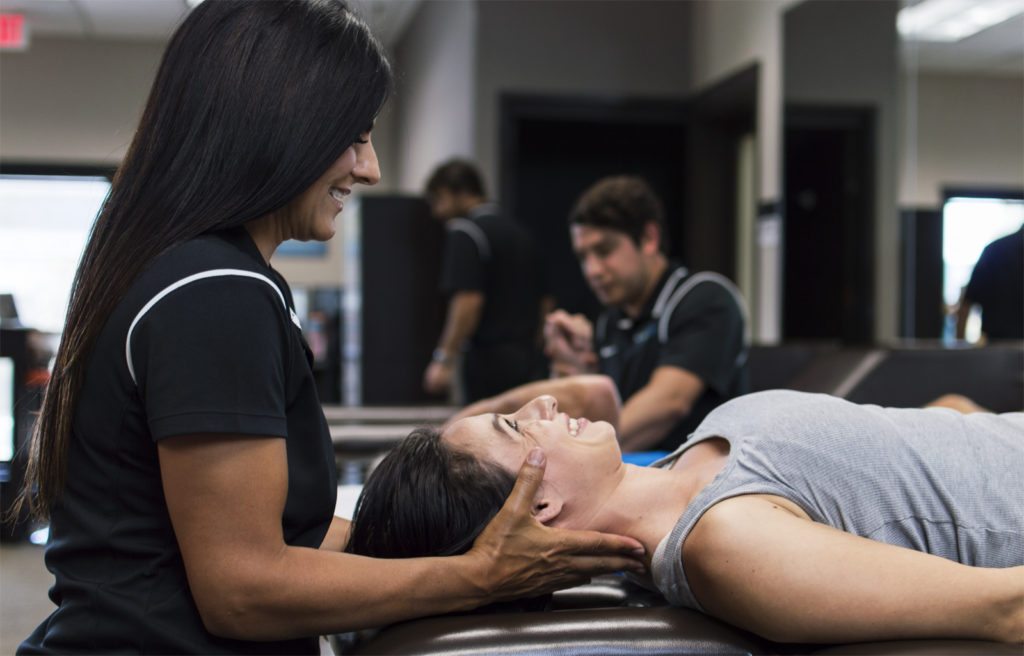Head/Neck

Head Anatomy
Bones in our head are a combination of several pieces that were previously free moving as infants but fuse together as we grow. The brain, its stem, and all its internal cranial nerves are protected by the skull, which is covered completely by temporal, parietal, mandibular, occipital, frontal, ethmoid and maxilla bones. Wrapping the bones are a mass of muscles, ligaments, nerve endings, glands, blood vessels and many connective tissues. Muscles connect the shoulders to the neck and head via the sternocleidomastoid, the trapezius muscle (one of the largest back muscles) connects the back to the highest point in the cervical spine to the head, etc. It’s understandable to feel pain in the shoulder that travels to the head and vice versa with this much connectivity from the back, neck, and head.
The head and neck are often a place where stress accumulates the most. How we hold weight when we carry things, and even the way we sit and walk can contribute to stresses on the cervical spine. Our cervical spine is one of the most delicate areas that can suffer from injury when we’re in an accident, or even when the neck is improperly placed when we sleep. Pain in this region may be attributed to the vertebral sections known as C1-C8. The C1 vertebra is called the atlas and is at the base of the head connected to the foramen magnum (the hole the spinal cord runs through from the brain into the spinal column). The unique formation of this specific first vertebrae allows the head freedom to nod up and down. The C2 vertebra is called the axis, and is shaped with a post-like protrusion that fits into the C1 vertebra above, to allow for head turns right and left. In addition to allowing full motion for the head and neck, the cervical vertebrae serve to protect the sensitive sections of the spinal cord that help to control breathing and bowel and bladder function. Three groups of muscles, arranged in several layers, help to support the weight of the head and neck, while allowing for full motion.
Head Anatomy
Bones in our head are a combination of several pieces that were previously free moving as infants but fuse together as we grow. The brain, brain stem, and all its internal cranial nerves are protected by the skull, which is comprised of the temporal, parietal, mandibular, occipital, frontal, ethmoid and maxilla bones. Wrapping around the bones are a mass of muscles, ligaments, nerve endings, glands, blood vessels and many connective tissues. The head and neck are connected to the shoulders via the sternocleidomastiod, trapezius, levator scapulae, and other smaller muscles. It’s understandable to feel pain in the head and neck, as well as the shoulder, due to the complex arrangement of these muscle groups.

Common Head Ailments We Treat
- Headaches
- Migraines
- Temporomandibular Joint (TMJ) Pain
- Bell’s Palsy
- Vertigo
- Stroke
- Movement Disorder
- Trigeminal Neuralgia
Neck Anatomy
The neck has the same components as the mid and lower back–intervertebral discs create cushion between vertebrae, and provide space for nerves to run from the spinal cord to the arms. Facet joints on the vertebra allow bones to glide smoothly against one another for comfortable, cushioned movement. As we age, these bones can become brittle, wearing on the cartilage and fibrous intervertebral discs designed to absorb shock in the neck during movements. Our muscles are prone to atrophy if they’re not properly stretched or exercised, and when we have poor posture. The longer these muscles remain neglected, the more they deteriorate, becoming stiff and thinned, making them susceptible to injury and acute or chronic pain.
At In Motion O.C., many of the clients that come in with back pain and headache concerns are actually referring to neck pain or a combination of neck and back strain. We will go through the common causes of neck pain and how you can try to reduce the pain with at home enhanced physical therapy exercises dictated by our Doctors of Physical Therapy (D.P.T.).
Common Causes Of Neck Pain
Cervical Stenosis
Stenosis of the spine refers to a shrinking or narrowing of the spinal canal where the spinal cord and its associated nerve branches are located. Should the cervical vertebrae suffer from stenosis, the spinal cord undergoes a varying amount of pressure that can pinch the cord and any nerves in the area where stenosis occurs. Any pinching of the spinal cord in the neck can cause painful spikes of irritation throughout the arms, shoulders, face, neck and hands. Cervical stenosis usually happens in the elderly, but can occur in younger people with early onset bone degenerative disorders or an acute injury to the neck.
Muscle Strain or Sprain
Improper weight bearing, incorrect sleep positioning, and poor posture can cause muscle strain or sprain. Tenderness, numbness or radiating pain are symptoms of muscle irritation. Abrupt injury to the neck muscles such as whiplash in collisions can strain the neck or tear the muscles and their ligaments. Often with injuries to neck muscles and tendons, clients range of motion is extremely limited. Depending on which muscles you injure, your shoulders, back, arms and chest can experience soreness, pain, and limited mobility as well.
Facet Joints and Cervical Arthritis
Facet joints are joints located between adjacent vertebrae. They allow for unobstructed gliding movements. Older clients may feel inflammation and irritation upon movement as these joints wear down and lose their cartilaginous layers, and bone surface is left exposed to rub against other bony surfaces. This facet joint syndrome often causes bone spurs to develop. Pain often radiates from here, so headaches occur as a secondary pain indicator.
Herniated Discs
Intervertebral discs can rupture or bulge out and add pressure to the nerves, causing pain in the neck, and also radiating down the arm.
Postural Issues
We are born with a natural curving of the spine which helps us remain upright and sit in a comfortable position so that nerve endings have space to extend freely, and circulation is uninterrupted. But when we have poor posture and hunch over, we have uneven weight distribution of the head on the neck and shoulders, and add unintentional stress to muscles and joints, causing pain. Everywhere these muscles connect experiences pain, even in places such as the arms, shoulders, head, and hands. Pain from improper posture is the results of tightly strained muscles and stressed joints. If left unaddressed, over time the neck and back can even curve further forward.
Emotional Stresses
High levels of stress can cause you to clench your jaw, and strain to your muscles, disrupt sleep and cause tension headaches eventually leading to chronic migraines. This often compounds and magnifies other physical impairments such as incorrect posture, disc conditions, and arthritis.

How to Reduce Your Head and Neck Pain
At the onset of any neck or back pain from strained muscles, it’s important that you get to rest. Too much rest isn’t beneficial for healthy muscles, but a couple of days at the most is what you need. Once the muscles have had time to relax, reintroducing movement and proper exercise is essential to help them regain strength and function. As muscles can become inflamed due to increased blood flow and trauma, ice packs can reduce any swelling. We also recommend heat with hot packs or heated blankets to reduce tensions accumulated with a stress injury.
Depending on the level of pain you experience and for how long, we recommend a custom treatment plan with physical therapy using assisted movements to help loosen up the muscles in the head and neck area. These exercises will improve joint motion and restore regular movement, reduce the pain, improve posture, and allow your muscles to extend their range with hands-on assistance from our physical therapists.

To reduce this, try over the counter anti-inflammatory medication such as aspirin or ibuprofen. We also recommend a series of stretches and exercises that combine stretch and stability skill building like yoga and Pilates. We offer our clients guided Pilates classes, structured for specific localized head and neck pain. At In Motion O.C., we also work with each client and any referring physician as they concurrently treat your condition.


If these exercises aren’t working for you, or you find difficulty performing them, please call In Motion O.C. to schedule your physical therapy consultation with one of our dedicated and skilled physical therapists today at 949.861.8600. Your pain doesn’t have to last forever, live pain-free with In Motion O.C.
*This information about physical therapy for head and neck ailments was reviewed by Dr Natalie Thomas, PT, DPT. If you have any questions, please don’t hesitate to contact us here.


